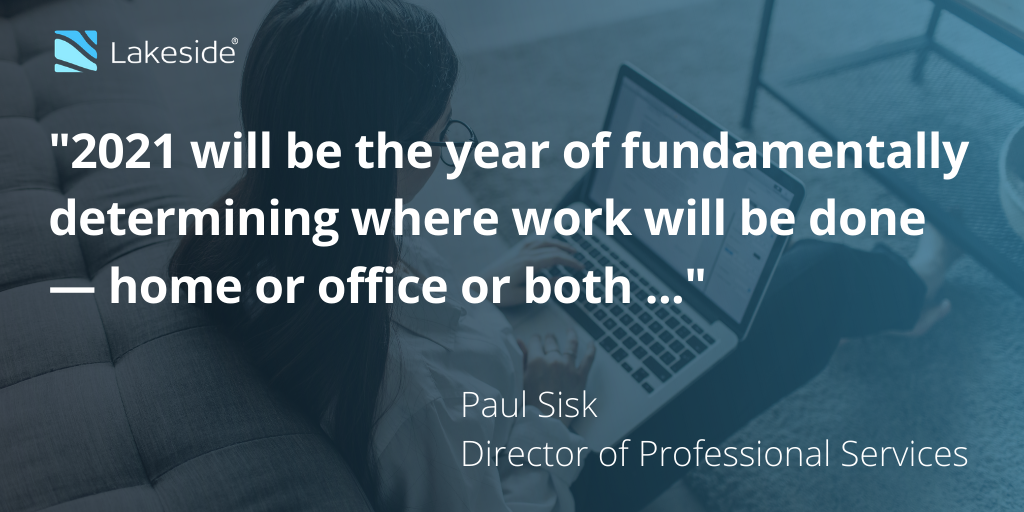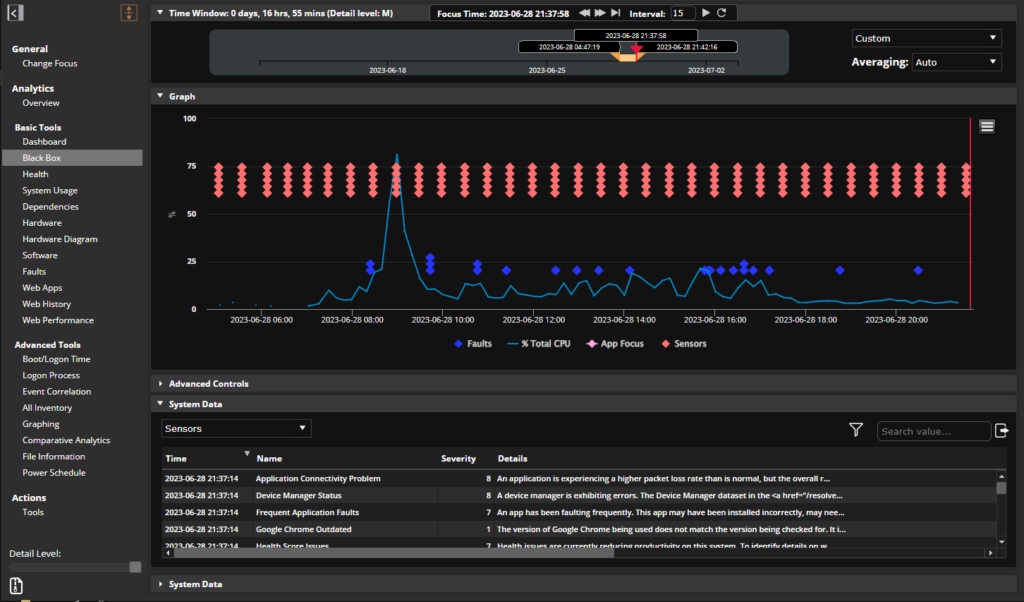
7 employee experience and DEM trends to follow in the coming year
Seems like forever ago that we anticipated which end-user computing trends would be the ones to watch in 2020. With insights from Lakesiders, we took a closer look at how DaaS growth, automation, virtual desktops and apps, and digital experience monitoring were among the most likely to influence IT strategies that year.
Of course, that was just two months before everything completely changed for organizations around the globe.
The coronavirus pandemic that escalated in early 2020 disrupted many IT strategies, pushing them to the background as organizations quickly shifted from working at the office to working from home. Our 2020 predictions and other digital experience trends, however, exploded with these rapid remote work changes. Organizations accelerated digital transformation, cloud adoption, and virtualization to adapt and preserve business continuity. Meanwhile, dispersed workforces drew more focus to digital employee experience (DEX) and productivity.
So as this year begins, we can’t help but wonder: What will be the next biggest IT trends to look for in 2021? Once again, our Lakeside experts share their thoughts on what to follow in the new year.
(INSERT TWEET)
Trend 1: Continued remote work along with some users returning to the office will make understanding and improving digital employee experience an even more pressing IT priority.
Although 2020 was undoubtedly the year of remote work, we expect it will be a big theme this year, too.
“2021 will be the year of fundamentally determining where work will be done — home or office or both,” observed Paul Sisk, Lakeside’s director of professional services, “and understanding how best to help our customers properly support those employees wherever they may be.”
A recent PwC US Remote Work Survey reveals 55% of employers anticipate most of their workers will want to work outside the office at least once a week, even after COVID-19 is no longer an issue. The survey also shows 72% of office workers would like to work away from the office at least two days a week — including 32% that would prefer to never go into the office.
It’s safe to say that remote and hybrid work are here to stay in 2021 and beyond, but the challenge going forward will be maintaining seamless, highly productivity digital experiences for spread-out workforces. IT will be tasked with making sure remote work experiences are just as good as — if not better than — those in the office.
Trend 2: Keeping things running smoothly for remote users on home networks will continue to be a challenging burden on IT through at least the first half of 2021.
Last year’s sudden shift to remote work taught us that working from home can be just as effective as working in the office, according to Ben Murphy, senior director of product management at Lakeside.
But it’s not enough to simply give users tools for collaboration and sharing experiences — such as Zoom, Slack, or Office and Microsoft 365. The real challenge is making sure employees can use these tools effectively and securely on home networks that are outside IT’s reach.
“Network performance quality is a persistent challenge when supporting remote workers,” Murphy noted. “The question for IT is ‘What can we do about it?’
“I think we’ll see a continued drive through at least H1 2021 to gain visibility into what’s happening on employees’ devices to determine whether an issue is one that IT can solve or if the user needs to take action to improve connectivity.”
Technology with endpoint monitoring and intelligent analysis will be crucial to help fill in those visibility gaps and give IT teams a starting point for developing remote support strategies with digital employee experience in mind.
(INSERT YOUTUBE VIDEO)
Trend 3: Increased growth of end-user cloud services and associated risks of outages will push IT to impose stronger SLAs on cloud vendors. Meanwhile, there will be a greater shift from tracking and measuring SLAs to tracking and measuring XLAs.
Now that organizations and remote workers rely more heavily on cloud apps and services, the stakes have never been higher for service level agreements (SLAs).
Along with the ease and convenience cloud technology and services offer, there’s also a large risk potential for outages, unreliable service, and downtime. Even slight interruptions — such as the Slack outage at the beginning of the year — could mean hours of lost productivity at the expense of organizations. That puts a lot of pressure on IT teams to demand higher standards from vendors and hold them accountable when business needs aren’t being met.
But while reliability, availability, and serviceability are important thresholds to establish with any technology/service vendor, they don’t always ensure exceptional digital employee experience. That distinction will likely lead many organizations toward experience level agreements (XLAs) versus traditional SLAs, and place greater importance on measuring digital experience.
“We are seeing more and more MSPs and system integrators shifting from traditional uptime, availability, and response time metrics used in SLAs to the inclusion of user experience scoring and sentiment data within XLAs,” according to Alister Gill, Lakeside’s managing director of global SIs. “2021 will see XLA-based metrics become the ‘new normal’ on managing service delivery.”
Trend 4: Advances in AI, machine learning, and automation will dramatically change incident management. At the same time, demand for better remediation will drive demand for stronger issue detection.
Although artificial intelligence for IT operations (AIOps) has been a growing trend for many years, it’s positioned to be even more of a driving force in 2021 as IT continues to support a dispersed workforce.
Because in light of remote-work challenges — dropped connections, video quality issues, slowness, app performance — the traditional, reactive approach to IT support just doesn’t work for employees who are miles and time zones apart.
“Everyone is moving toward an automated way to predict and prevent those problems before they start impacting users,” Lakeside Software founder and CEO Mike Schumacher said.
By implementing machine learning and automation to help remediate issues quickly — or sometimes before they even happen — organizations can spend less time and resources on service tickets, reduce downtime, and improve overall digital employee experience.
“It’s all about detection,” Schumacher added. “I compare it a lot to my truck. If I have a transmission problem, when I take it to the shop, undoubtedly, it’ll be perfect and the mechanic will say, ‘Well, I don’t know what to tell you. It’s working fine today.’
“Having the ability to detect that problem, understand what it is at the time that it’s happening, and have a record of that is really key.”
That’s where a digital experience monitoring (DEM) platform becomes an ideal solution. By collecting substantial amounts of deep data, organizations can implement better AI-powered detection and remediation.
“To achieve high levels of automated self-healing, you need a DEM product which collects thousands of data points — not hundreds,” according to David Taylor, EMEA channel and alliances director at Lakeside.
Trend 5: Digital experience monitoring will be implemented to help improve productivity across most organizations.
If 2020 taught us anything about business strategy, it’s that organizations need to stay nimble.
But without knowing exactly what challenges they might face down the road, enterprises must constantly look for smarter ways to predict, prepare, and mitigate those forces as much as possible.
That’s where technology plays a vital role.
“Many businesses have ultimately realized that … to be successful in 2021, they will need to continually evolve,” observed Richard Edwards, Lakeside’s technical director in EMEA. “Now more than ever understand that in order to be more agile in their approach, they will need to look towards software and technology for answers, more specifically the EUEM/DEM analytics marketplace.”
Organizations of all kinds — including those in healthcare, manufacturing, insurance, banking, retail, government — already look to digital experience monitoring as more than just an IT solution. They’re able to find business solutions, and often achieve a high ROI, too, with expanded visibility, productivity management, asset optimization, compliance reporting, and more.
And in 2021, we expect more enterprises across industries will follow suit.
Trend 6: CIOs and HR leaders will adopt digital employee experience scoring as a top KPI.
Employee experience won’t just be a concern for IT departments in 2021. It will also be a guide for higher-level executives as they drive businesses to grow and become more competitive.
Because along with the main benefit of exceptional digital employee experience — happy and productive workers — there are other desirable business outcomes, including better recruiting and retention, technology innovation, and even a higher ROI.
None of that can happen, though, without first tracking employee experience. And by quantifying and measuring the availability and performance of factors that can impact end-user experience and productivity, organizations can use a digital experience score, or end-user experience score, to do just that.
“The digital experience score will become a fundamental, key metric for CIOs,” observed Dan Salinas, Lakeside’s vice president of sales and business development.
Trend 7: Digital experience monitoring will increasingly focus on measurable results and business outcomes.
While digital employee experience will undoubtedly be the most important KPI of the year, it certainly won’t be the only one. Digital experience monitoring will also inform organizations about their business growth, costs and savings, engagement, and other outcomes through objective, reportable data.
“Expectations from DEM tools shall evolve beyond monitoring and improving user experience to providing detailed insights into improving workspace delivery platforms, measuring employee productivity, and monitoring security/compliance in borderless workspaces,” noted Anuj Khandelwal, Lakeside’s general manager and SI director in India.
Strategists and decision makers will also look to DEM for measurable results from experience level agreements (XLAs) ; hardware and software refreshes and other technology innovations; asset optimizations; and license allocations.
Those discoveries will not only help measure the success of 2021, but also lead to more ambitious goal planning in the years to follow.
Subscribe to the Lakeside Newsletter
Receive platform tips, release updates, news and more










